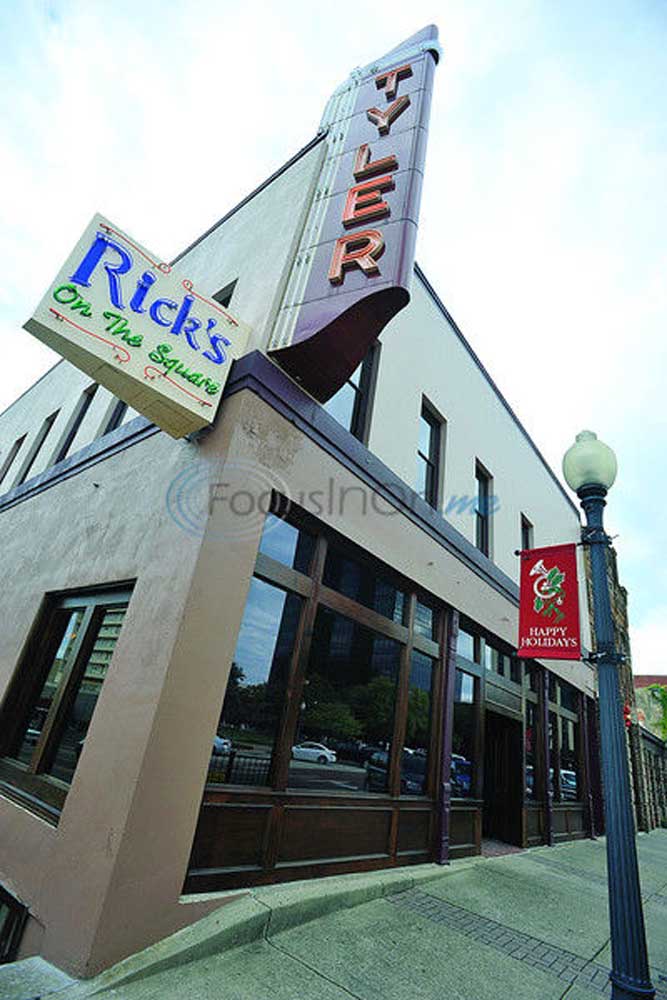Council to consider removing Rick’s on the Square from Tyler Historical Landmark register
Published 5:52 pm Monday, November 9, 2015

- Rick's on the Square on Erwin Street in downtown Tyler. Owner Rick Eltife, who's been in business at the location for 23 years, is at loggerheads with the local historical commission over improvements he's made to the building and has requested removal of the building's historical designation. Andrew D. Brosig/Tyler Morning Telegraph
An iconic downtown building is losing its local landmark status.
After a disagreement on renovations, Rick’s on the Square owner Rick Eltife applied to have the city’s Historic Preservation Board remove his Tyler Historic Landmark status and plaque.
The Tyler City Council will make the final decision on removing the designation Wednesday during its regular meeting at 9 a.m. in City Hall, 212 N. Bonner Ave.
The B.W. Rowland-Liebreich Building sits at the intersection of Broadway Avenue and Erwin Street on the corner of the T.B. Butler Fountain Plaza.
The iconic “Tyler” neon sign hangs from the side of the building and has become a symbol of old Tyler. The sign also is featured on the Historic Preservation Board’s landmark plaques and has its own historical designation, which will not be affected.
Eltife is the first applicant to want to get off the local landmark list since the program began in 1983, according to Amber Rojas, the city’s historical preservation officer. Currently, 109 buildings and signs are registered. Those on the registry have the ability to get a 50 percent break on city taxes.
“We don’t look at what goes on in the interior,” Ms. Rojas said of what aspects the Historic Preservation Board governs. “We understand historic homes need updating over the decades, and things inside is up to the homeowners. We don’t look at the interior at all. We mainly look at the historical integrity being maintained (from the outside).”
Eltife bought his building in 1990, opened his restaurant in 1992 and is credited with helping revitalize downtown.
The building has gone through multiple renovations over the years, but Eltife said he has kept its history in mind.
“I’ve invested a lot of money and 25 years of my life,” Eltife said. “It’s more than just a project. I put my life and blood, sweat and tears, my dedication and my money into that (building). I love it.”
But when Eltife decided to replace the existing exterior wood finish with mahogany and the windows with energy efficient glass, the historical board told him he needed permission first.
“It looked good before, but the construction was 20 years old,” he said. “Instead of redoing the wood and painting it, I decided to really redo it.”
Ms. Rojas said the renovations changed the look of the outside of the building. She said the mahogany wasn’t the only change made.
“On the east side, he took off all the outside of the original façade (that was there) when it was approved,” she said. “He had repainted it and changed the texture of it as well as sandblasting the brick and reorienting some of the windows. It was changing the original look of the façade.”
Eltife felt nitpicked and decided to let the designation go, submitting a letter to the city’s historical preservation board, which approved allowing him to get off the list. Council approval is the final step in the process.
“I think it looks beautiful,” he said, adding the mahogany is real wood, not a finish or stain. “They want to tell you what kind of windows you can use, and by the time they get done with it, it costs twice as much. I’ve spent millions over the years, and I haven’t done anything that doesn’t look good or preserve the integrity of the history of the building. I’ve put it back like it would have been done in the 1880s.”
Ms. Rojas said the program is voluntary and allows landowners to get out of the program if they want to make changes to the historical face of their buildings.
“He is a local landmark agreeing to be on the registry to uphold the guidelines,” she said.
Eltife said his commitment to downtown runs deep. Once the outside renovations to his restaurant are complete, he plans to work on making the old Tyler theater marquis area more attractive.
“The lobby of the Tyler Theater, that’s strictly aesthetics,” he said. “The money I put into that, I’m not going to get back. “You can’t do it all at once. I’m steady at it, and I’m not done – that’s next.”
Twitter: @TMTFaith
HISTORY
The B.W. Rowland-Liebreich Building, at 100 and 104 W. Erwin St., was constructed in 1888, according to the historic preservation board website. It is located on the original site of the El Ranch Saloon, and is noted for a regionally-famous shooting during the reconstruction era involving local residents and law officials, the website reads.
The portion of the building now located at 100 W. Erwin St. was the home of the East Texas Conservatory of Music, established by Ms. Estelle Burns. Ms. Burns, nationally recognized for teaching “voice culture” was recognized in New York City as the head of the Vocal Department of the National Academy of Music Art, according to the board.
Also on the agenda:
In other business at Wednesday’s meeting, the City Council will:
– Hear a presentation on the findings of an internal study on the Tyler Municipal Court’s internal processes.
– Make an appointment to the Smith County appraisal District Board of Directors
– Hear a presentation on the possible widening of a portion of Elm Street by a developer.






